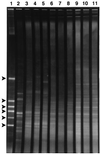Microbial biomass and activity in lead-contaminated soil
- PMID: 10224032
- PMCID: PMC91329
- DOI: 10.1128/AEM.65.5.2256-2259.1999
Microbial biomass and activity in lead-contaminated soil
Abstract
Microbial community diversity, potential microbial activity, and metal resistance were determined in three soils whose lead contents ranged from 0.00039 to 48 mmol of Pb kg of soil-1. Biomass levels were directly related to lead content. A molecular analysis of 16S rRNAs suggested that each soil contained a complex, diverse microbial community. A statistical analysis of the phospholipid fatty acids indicated that the community in the soil having the highest lead content was not related to the communities in the other soils. All of the soils contained active microbial populations that mineralized [14C]glucose. In all samples, 10 to 15% of the total culturable bacteria were Pb resistant and had MIC of Pb for growth of 100 to 150 &mgr;M.
Figures



References
-
- Aoyama M, Nagumo T. Effects of heavy metal accumulation in apple orchard soils on microbial biomass and microbial activities. Soil Sci Plant Nutr. 1997;43:601–612.
-
- Bartha R, Pramer D. Features of a flask and method for measuring the persistence and biological effects of pesticides in soil. Soil Sci. 1965;100:68–70.
LinkOut - more resources
Full Text Sources

